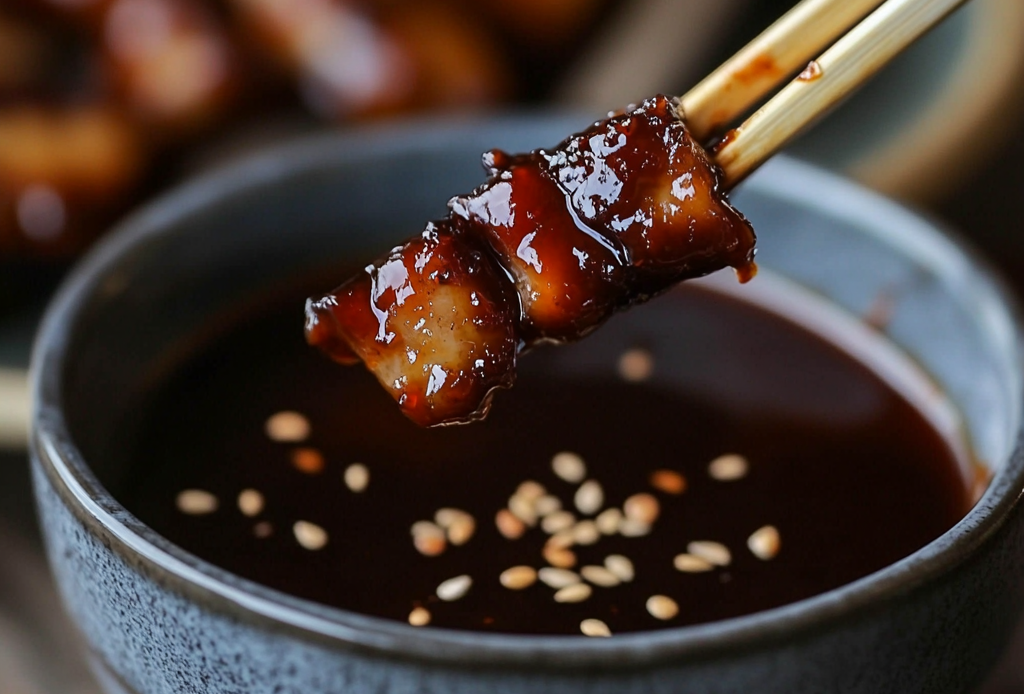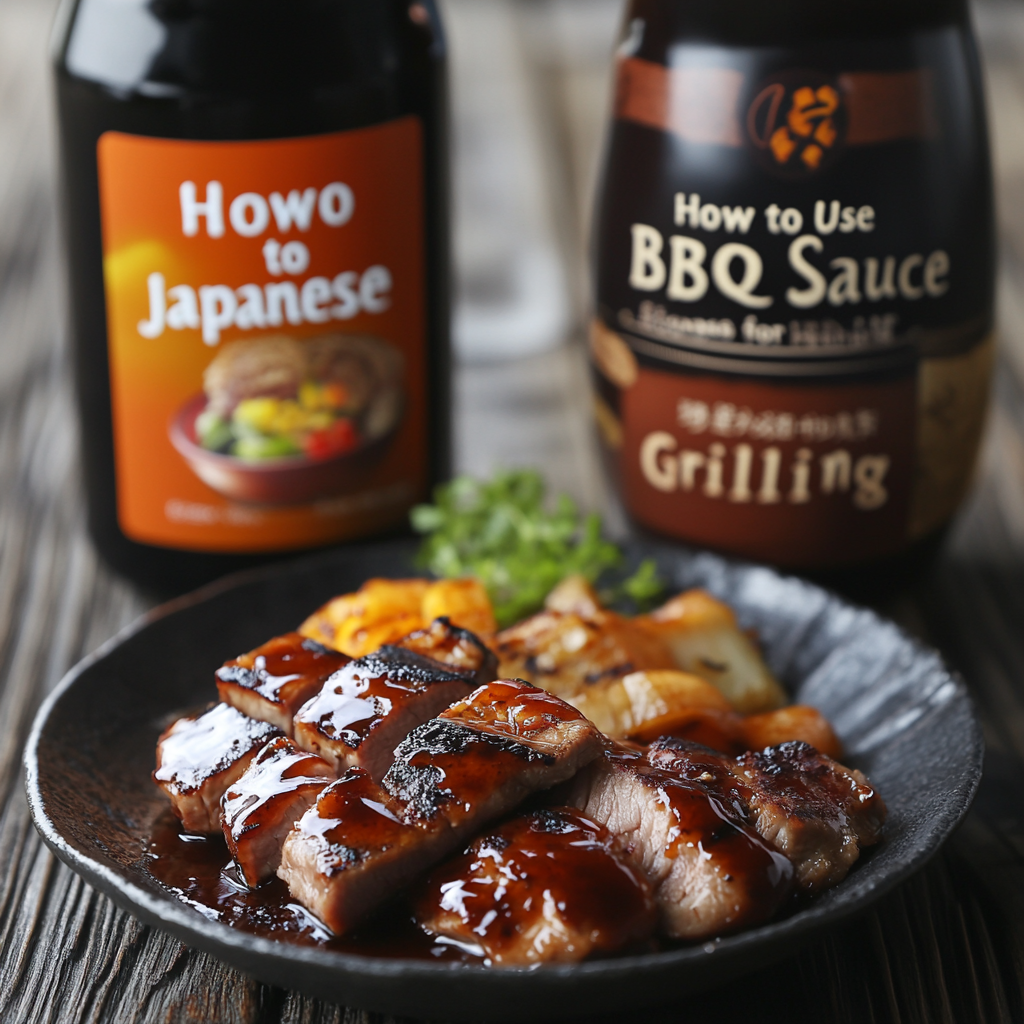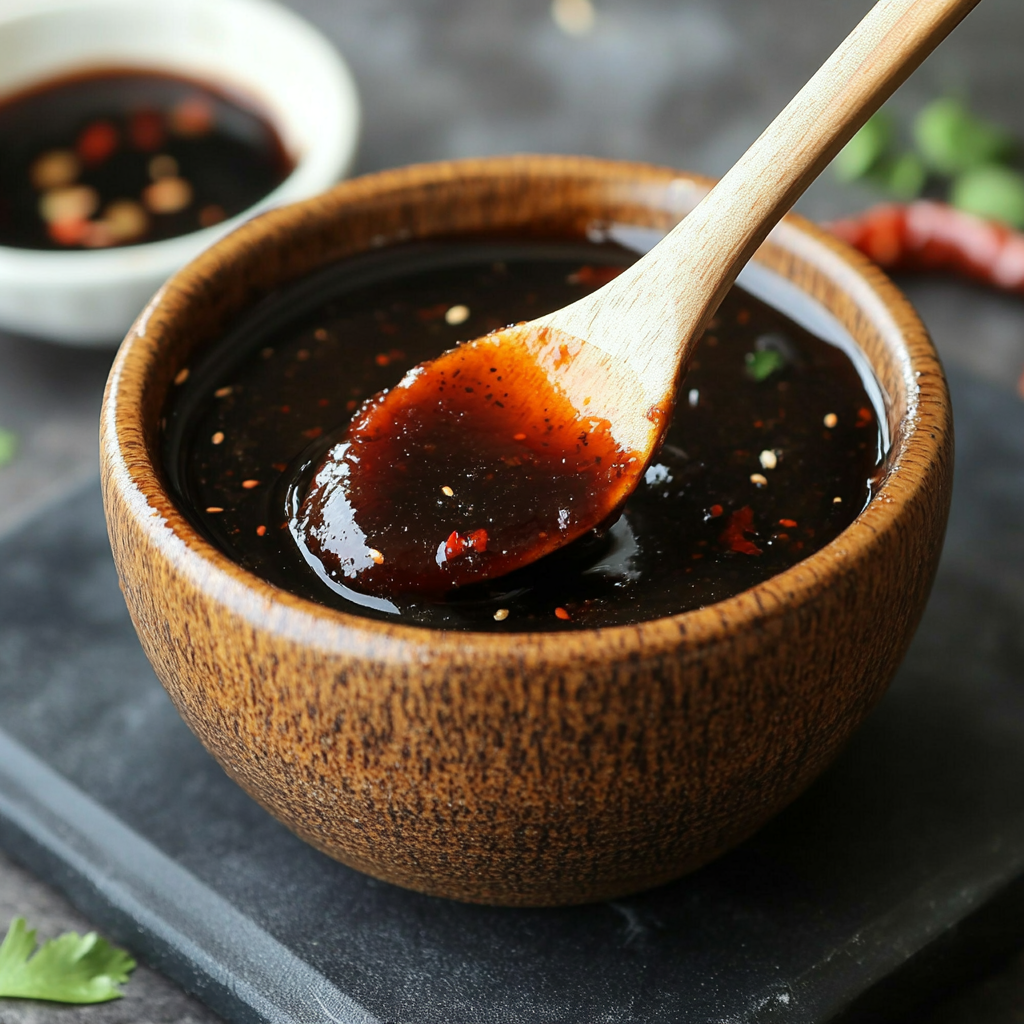
Do you remember that first time you tasted a tangy-sweet glaze at your favorite sushi spot? You can make that flavor at home, without preservatives or extra sodium. Making your own Asian BBQ sauce is more than just convenience. It’s about creating your own culinary tradition.
Whether you’re making Japanese BBQ sauce for teriyaki chicken or trying out chili-infused marinades, cooking at home is special. Asian BBQ sauces are different from Western ones. They use soy, fish sauce, and rice vinegar for a rich, savory taste that store-bought sauces can’t match. This guide will teach you how to pick the right ingredients and adjust the sweetness to your liking.
Key Takeaways
- Customize flavors to suit your palate with fresh ingredients.
- Discover how soy sauce, mirin, and ginger form the backbone of authentic asian bbq sauce.
- Learn the differences between Japanese, Korean, and Chinese BBQ traditions.
- Follow clear steps to avoid common pitfalls like overly salty or sticky textures.
- Store your homemade sauce safely and use it creatively beyond grilling.

Understanding Asian BBQ Sauce Varieties
Asian BBQ sauces come from long traditions, with each area making its own unique flavors. From Korea’s spicy sauces to Japan’s rich umami, these sauces make meats and veggies taste great. Let’s dive into what makes them special.
Japanese Yakiniku vs. Korean Bulgogi Sauce
The Japanese yakiniku sauce recipe uses soy sauce, mirin, and sugar for a clean taste. It’s perfect with thin beef slices grilled at your table. Korean bulgogi sauce, on the other hand, mixes pear purée, chili flakes, and sesame oil. This sweet-spicy blend tenderizes even tough cuts.
Chinese Char Siu vs. Southeast Asian Styles
Chinese char siu gets its deep red color from hoisin sauce and five-spice powder. Southeast Asian sauces, like Thai or Vietnamese, are full of lemongrass, fish sauce, and lime. These show how place affects flavor—char siu’s sweetness contrasts with the zesty Malay rendang glazes.
Common Flavor Profiles Across Asian BBQ Traditions
All asian bbq sauce recipes have key elements. Soy sauce adds umami, garlic and ginger warm it up, and sugar balances the acidity. Many include chili for heat, creating a sweet-savory mix. These shared ingredients let you try new things while honoring tradition.
The Rich History of Asian BBQ Sauces
Asian BBQ sauce traditions go back thousands of years. They started with ancient grilling methods. Early recipes helped tenderize meat and add flavor with marinades.
In Japan, cooks used fermented soybean pastes for yakiniku. Korean bulgogi used soy sauce and sesame oil. These sauces were more than ingredients; they were part of cultural meals and rituals.
- Chinese char siu sauce started in Guangdong in the 1600s. It used honey and hoisin to glaze meats.
- Trade on the Silk Road brought chili peppers and citrus to Southeast Asia. This changed local BBQ flavors.
- Family recipes were kept secret. They were passed down through generations in notes or words.
Ingredients like mirin and palm sugar became key as trade grew. Spices from India and the Middle East, like star anise and black pepper, added to regional flavors. Today’s asian bbq sauce shows this mix of history and geography. Making your own sauce keeps alive traditions from royal banquets to village feasts.
Early sauces were made in small batches with local ingredients. Japanese soy sauce production started over 1,000 years ago. By learning these ingredients, you respect a legacy that shaped global food.
Essential Ingredients for Authentic Asian BBQ Sauce
Creating the perfect homemade japanese bbq sauce begins with the right ingredients. These key elements form the foundation of any asian bbq sauce. They balance bold flavors and honor cultural traditions. Let’s explore what you need to make a sauce that’s both true to its roots and versatile.
Umami-Building Foundations
Start with umami-rich bases like soy sauce (light for saltiness, dark soy for depth), tamari for gluten-free options, and fish sauce for savory depth. Miso and doenjang bring earthiness—white miso for milder sauces, red miso for bolder. These fermented ingredients are crucial for authenticity.
Sweeteners and Their Impact
Sweetness levels differ by region. Mirin adds a subtle sweetness without being too sweet, while brown sugar enhances caramel notes. Honey or fruit juices like pineapple can be substitutes, but mirin is essential for homemade japanese bbq sauce. Adjust the sweetness to balance the heat and richness.
Spices and Aromatics
- Garlic and ginger: Grate fresh for maximum punch, or use minced for convenience.
- Sesame oil: Adds nutty richness—use sparingly to avoid overpowering.
- Chili peppers: Fresh or dried, adjust based on spice preference.
- Five-spice powder or star anise: Essential for Chinese-inspired sauces, but skip in Japanese styles.
Regional Ingredient Variations
Japanese recipes often use rice vinegar and light soy sauce. Korean styles might add gochujang or pear puree, while Thai versions use lemongrass or galangal. If you can’t find something, substitute fish sauce with soy sauce + oyster sauce, or maple syrup for mirin. Most cities have Asian markets, but online retailers like H mart.com or Amazon also offer specialty items.
Equipment You’ll Need for Homemade BBQ Sauce
Making homemade japanese bbq sauce needs more than just ingredients. You also need the right tools and storage solutions. Let’s look at what you’ll need to make the process easier and ensure your sauce is perfect.
Basic Kitchen Tools
First, you’ll need a mixing bowl to mix ingredients. A heavy-bottomed saucepan is key to prevent burning. Use a whisk or immersion blender for smooth blending. For accurate measurements, use measuring spoons and a liquid measuring cup.
Pro tip: A silicone spatula gets every last bit of sauce from pots.
- Mixing Bowls: Ceramic or stainless steel for even heat.
- Blending Tools: Immersion blender (e.g., Cuisinart) or manual whisk for texture control.
- Pots: Stainless steel or enameled cast iron for even simmering.
Storage Containers
Choose containers that keep your homemade japanese bbq sauce fresh. Here’s a comparison of options:
| Container Type | Pros | Cons | Best For |
|---|---|---|---|
| Glass Jars (Ball, Pyrex) | Non-reactive, UV-resistant, reusable | Heavy, potential breakage | Long-term storage, pantry display |
| Plastic Containers (Rubbermaid) | Lightweight, shatter-resistant | Can leach odors, less durable | Short-term use, freezer storage |
“Glass jars are ideal for homemade japanese bbq sauce—they preserve flavor integrity without imparting tastes,” says Chef Yuki Tanaka of Tokyo’s Sake no Ya.

Always sterilize containers before use. Wash in hot soapy water, rinse, and dry completely. Label jars with dates and sauce type for clarity. Airtight seals are crucial for freshness.
Step-by-Step Asian BBQ Sauce Recipe
Start making your own asian bbq sauce with this basic recipe. Follow these steps to make a great base for your grilled foods:
| Ingredient | Amount |
|---|---|
| Soy sauce | ½ cup |
| Ketchup | ¼ cup |
| Honey | 3 tbsp |
| Minced garlic | 2 tsp |
| Minced ginger | 1 tsp |
| Hot sauce | 1 tbsp |
| Sesame oil | 1 tsp |
- In a saucepan, mix soy sauce, ketchup, and honey. Heat on medium until it’s warm.
- Add garlic, ginger, and hot sauce. Cook for 2 minutes until it smells good.
- Slowly add sesame oil. Simmer uncovered for 10-12 minutes until it thickens.
- Take it off the heat. Let it cool down to room temperature before using.
- Store it in airtight containers for up to 2 weeks.
Pro tip: Taste it after simmering. Add honey for sweetness or rice vinegar for acidity if needed. This homemade japanese bbq sauce base can get richer with mirin or sake. Don’t overcrowd the pan to avoid burning the spices.
“Simmering time directly impacts thickness—longer cooking reduces moisture for sticky glazes,” says culinary expert Chef Linh Tran.
For a thinner sauce, add water 1 tbsp at a time. Whisk well with each addition to keep the balance. This base recipe is your starting point for exploring different flavors in the next section.
Regional Variations to Try at Home
Expand your homemade japanese bbq sauce repertoire with these three recipes. Each showcases unique regional flavors and ingredients, great for grilling or marinades.
Japanese Yakiniku Sauce Recipe
The yakiniku sauce recipe is a mix of soy sauce, mirin, and sugar. It’s all about umami. Here’s how to make it:
- Mix 1/2 cup soy sauce, 1/4 cup mirin, 2 tbsp sugar, and 2 tbsp sake in a saucepan.
- Simmer until thickened, stirring often. Add 1 tsp grated apple or minced garlic for brightness.
- Use as a marinade for beef or basting sauce during grilling.
Korean-Inspired Sweet and Spicy Sauce
Combine 1/4 cup gochujang, 2 tbsp honey, 1 minced garlic clove, and 1 tbsp sesame oil. Add 1 tsp rice vinegar and 1/2 tsp black pepper. Brush on pork or chicken for a fiery kick.
Chinese Char Siu-Style Sauce
Make a sticky glaze with 3 tbsp hoisin sauce, 1 tbsp five-spice powder, 2 tbsp honey, and 1/2 tsp red chili flakes. Simmer until glossy—ideal for pork chops or bao buns.
| Sauce Type | Key Ingredients | Flavor Notes | Use Cases |
|---|---|---|---|
| Japanese Yakiniku | Soy sauce, mirin, grated apple | Umami-sweet | Beef, grilled veggies |
| Korean Sweet & Spicy | Gochujang, sesame oil | Fiery-sweet | Chicken skewers, bibimbap |
| Char Siu | Hoisin, five-spice | Sweet-smoky | Pork, stir-fries |
Try local substitutes like mirin for rice wine or honey for palm sugar. Adjust the spice to your liking while keeping the cultural essence.
How to Use Japanese BBQ Sauce in Your Cooking
Learning how to use japanese bbq sauce opens up a world of flavors. This yakiniku sauce recipe is perfect when matched with the right ingredients and cooking methods. Here are some tips to avoid burning the sauce and to bring out the best taste.
Perfect Meat Pairings
- Beef: Marinate wagyu or ribeye for 2–4 hours before grilling at 375°F. Brush during the last 5 minutes to prevent sugar burning.
- Chicken: Use thighs—coat with sauce halfway through cooking for a sticky crust.
- Pork: Apply to belly slices during the final 10 minutes of pan-searing.
- Seafood: Drizzle salmon or shrimp in the last 2 minutes of grilling for a subtle glaze.
Vegetable Glazing Techniques
Brush yakiniku sauce recipe on eggplant, mushrooms, or bell peppers during the last 5–7 minutes of grilling. Aim for a glossy sheen—not charred edges. For roasted veggies, toss with sauce 10 minutes before done.
Beyond Grilling: Other Culinary Applications
“The sauce’s umami depth adapts to both traditional and modern dishes.”
- Stir-Fry: Add 2 tbsp in the last minute of cooking for a savory kick.
- Dipping Sauce: Mix equal parts sauce and mayo for sushi rolls or gyoza.
- Rice Bowls: Drizzle over donburi or bibimbap for instant umami depth.
- Fusion Fare: Use as a glaze for pulled pork sandwiches or atop ramen bowls.
Adjust application timing based on heat intensity. Save delicate flavors for the end of high-heat dishes to preserve complexity.
Store-Bought vs. Homemade: Is Japanese Barbecue Sauce from Costco Worth It?
Deciding between japanese barbecue sauce costco and homemade japanese bbq sauce depends on what matters most to you. Costco’s Kirkland Signature Teriyaki Sauce is a convenient choice, priced at about $5 for 16 oz. It brings bold soy-sweet flavors to your table. Yet, many store-bought sauces add preservatives and extra sugar, unlike traditional recipes.
- Flavor: Making your own sauce lets you fine-tune the soy, mirin, and ginger to your liking. This way, you avoid artificial additives. Costco’s sauce is classic but might not have the same depth as homemade.
- Cost: Homemade sauce costs around $3-$5, similar to Costco’s price. Making large batches can make each serving even cheaper.
- Time: Store-bought saves time but limits your ability to customize. Making your own homemade japanese bbq sauce takes just 10 minutes. You can adjust the spice levels or reduce sodium to your liking.
- Shelf Life: Costco’s sauce stays good for 6 months if unopened. Homemade sauce, on the other hand, lasts 2 weeks in the fridge. This is perfect for making small batches.
“Ingredients include high-fructose corn syrup and sodium benzoate,” warns a nutritionist, referencing Costco’s label. “Homemade uses brown sugar and skips preservatives.”
If you’re looking for a quick meal solution, Costco’s japanese barbecue sauce costco is great for marinating or glazing. For special occasions or dietary preferences, making your own homemade japanese bbq sauce ensures top quality and freshness. Ultimately, the choice is yours, based on your lifestyle and preferences.
Storing Your Homemade Asian BBQ Sauce
Keeping your asian bbq sauce fresh and safe is key. Follow these steps to keep your homemade Japanese BBQ sauce good for longer:
Refrigeration Guidelines
First, cool the sauce to room temperature before sealing. Use airtight glass jars or containers for up to 3 weeks. Sauces with fresh garlic or ginger should be used in 1-2 weeks.
When reheating, do it gently on the stove. Never boil. Adding a splash of rice vinegar helps prevent bacterial growth.
Freezing Options
- Pack sauces in ice cube trays or freezer-safe bags. Make sure to leave space for expansion.
- Thaw frozen portions in the fridge overnight. Sauces with cornstarch might separate—stir well after thawing.
- Use within 3 months for the best flavor. Don’t freeze citrus-based sauces as acidity can damage pectins.
Signs Your Sauce Has Gone Bad
Throw away the sauce if you see:
- Foaming or mold on the surface
- Strong vinegar-like smells
- Slippery or stringy textures
“When in doubt, throw it out—safety comes first with homemade sauces,” advise food safety experts at the USDA.
Troubleshooting Common Problems With Your Asian BBQ Sauce
Sometimes asian bbq sauce or yakiniku sauce recipe might not turn out right. Here are quick fixes for common issues:
Fixing Texture Issues
If your sauce looks separated or feels grainy, try these fixes:
- Separation: Reheat it gently while whisking. Add 1 tsp cornstarch mixed with water to stabilize.
- Graininess: Blend the sauce in a blender. Strain it through a fine mesh sieve to remove solids.
Balancing Flavors
Use this chart to adjust taste imbalances:
| Issue | Fix | Example |
|---|---|---|
| Too sweet | Add ½ tsp rice vinegar or soy sauce | Saltiness overpowers honey in yakiniku sauce recipe |
| Too salty | Mix in 1 tbsp brown sugar | Over-seasoned bulgogi-style sauce |
“Taste as you adjust—small changes make big differences.” – Chef Han Meimei, Tokyo Grill Masters
Adjusting Thickness
Follow these steps for consistency:
- To thicken runny sauce: Simmer uncovered to reduce by ¼ or mix 1 tsp cornstarch with 2 tbsp water, then stir in.
- To thin overly thick sauce: Add 1–2 tbsp broth or water gradually.
Understanding why these work helps: Reducing liquid concentrates flavors while thickening agents form gels. Adjust slowly to avoid overcorrecting.
Conclusion
Making your own Asian BBQ sauce at home lets you create bold flavors just the way you like them. You can make Japanese yakiniku, Korean bulgogi, or Chinese char siu styles. By using ingredients like soy sauce, ginger, or chili pastes, you can adjust the flavors to fit any dish perfectly.
Try using Japanese BBQ sauce in new ways, like on roasted veggies or over rice bowls. You can also mix it into stir-fries. Experiment with different ingredients, like swapping honey for brown sugar or adding fresh herbs. Each change helps you get closer to your perfect flavor.
Share your sauce creations online or use tips to improve your recipes. With homemade sauce, you’re not just cooking. You’re bringing global traditions to your kitchen, turning simple ingredients into something amazing. Start with a base recipe, tweak the spices, and watch your meals become authentic and delicious.
FAQ
What is Asian BBQ sauce?
Asian BBQ sauce is a mix of savory, sweet, and umami tastes. It’s found in many Asian dishes. It includes soy sauce, mirin, garlic, and spices, making it different from Western BBQ sauces.
How can I make a homemade Japanese BBQ sauce?
To make Japanese BBQ sauce at home, mix soy sauce, mirin, sake, and sugar. Adjust the mix to your taste. You can also add grated fruit or garlic chips for more flavor.
What dishes pair well with Japanese BBQ sauce?
Japanese BBQ sauce is great with grilled meats like beef, chicken, and pork. It’s also good for glazing veggies or adding flavor to stir-fries and rice dishes.
Can I find Japanese BBQ sauce at Costco?
Yes, Costco sells many Japanese BBQ sauce brands. They often have high-quality ingredients. Check your local store for what’s available.
What is a simple yakiniku sauce recipe?
A simple yakiniku sauce has soy sauce, mirin, sake, sugar, and garlic. Simmer the mix to dissolve the sugar. Adjust the sweetness and umami to your taste.
How do I store my homemade Asian BBQ sauce?
Keep homemade Asian BBQ sauce in an airtight container in the fridge for up to two weeks. Freeze it in ice cube trays for easy use later.
What are common flavor profiles in Asian BBQ sauces?
Asian BBQ sauces often have sweet, savory, and umami flavors. Ingredients like soy sauce, sugar, sesame oil, and garlic create these tastes. Regional flavors add unique twists.
How can I customize my Japanese BBQ sauce?
Customize your Japanese BBQ sauce by adding chili for heat, fruit for sweetness, or spices. Feel free to experiment and find your favorite flavor.
What if my sauce is too salty or sweet?
If your sauce is too salty, add a bit of sugar, honey, or water. For sweetness, try vinegar or soy sauce. This adds complexity to your sauce.
Are there vegan options for Asian BBQ sauce?
Yes, vegan Asian BBQ sauces are possible. Use soy sauce or liquid aminos instead of fish sauce. Maple syrup or agave can replace honey for sweetness.
What is the cost difference between store-bought and homemade Japanese BBQ sauce?
Store-bought Japanese BBQ sauce costs about to per bottle. Homemade versions can be cheaper. You control the quality and amount of ingredients.




